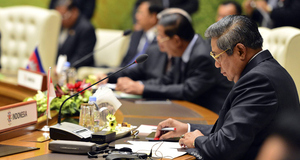From Cornell International Affairs Review VOL. 6 NO. 2Prospect of Northeast Asian Regionalism: Comparative Case Study of Southeast Asia and Northeast AsiaUS or China: Differing Perception of Threat in East AsiaIn regards to perception of common threat that Katzenstein argued was one of the main components of multilateralism, I would argue that as far as the US remains as a global hegemon and North Korea and China remain major, nondemocratic powers, US-Korea and US-Japan alliances will not be breached. US-Korea relationship has been strongly maintained since 1950s and the evidence in current affairs can be seen firstly from Korea's regular joint military exercises with the US, and the naval exercise in November 2010 as a reaction to North Korea's artillery attack on the island of Yeonpyeong. Despite China's anger which led them to "warn against any military act in its exclusive economic zone without permission"34, Korea's decision to go ahead with the military exercise with the US shows that Korea's concern for its security is greater than the historic hierarchic system that Kang is arguing for, and is greater than the projected economic benefits that Korea would gain from aligning with China. Further, the recent threats of military conflict posed by North Korea led international community, including US senators, to urge China to take action and led US and Korea to conduct ongoing joint military exercises. Yet, China has remained reluctant to take action, and Korea has not been pushing China to do so, either. This shows Korea's greater reliance on its long-standing ally, the US, rather than China. The majority of Korea's foreign policy strategy researchers conclude that Korea should align keep strong bonds with the US: they argue that the disruption in US-Korea relations would not be limited to security area but also economy and trade, therefore the US-Korea security alliance needs to be maintained and strengthened. The alliance is also important because the US-Korea alliance does not only concern the Korean peninsula but the security issues of the Asia-Pacific, and will extend to become the basis for multilateral security cooperation.35 The US-Korea relations seems to have almost absolute priority over any other bilateral relations for Korea, even though a Korea-China-Japan FTA is being discussed which, when is signed, is estimated to bring about a 1.45% increase in Korea's GDP.36 Japan's perception of threat or alliance is similar to that of Korea: Japan places emphasis on its alliance with the US, as seen in Japan's annual Diplomatic Bluebooks.37 US-Japan relationship has been strengthening in 21st century, and Kim argues that this is due to an increasing perception of threat of China in the region.38 Kim argues that after the Pacific War, Japan's diplomatic strategies have developed to escape from US pressure in order to have independent international position, but at the same time, through strengthening the alliance between US and Japan has pursued realistic foreign policies.39 As for Japan's policies towards China, it can be seen as balancing against it in political and military aspects. China's economic and military ascension serves as a great challenge to Japan.40 This idea of balancing against China is resonant in Japan's shifting military strategy to: providing its first military aid overseas since the end of WWII, approving a $2 million package for its military engineers to train troops in Cambodia and east Timor, and amending of the Atomic Energy Basic Law to allow the use of nuclear power for "national security."41 The driving force behind Japan's shift in security strategy has been argued to be the dispute with China over the uninhabited islands in the East China Sea, and the financial struggles of the United States, which are leaving Japan vulnerable.42 Yeonpyeong Island: On the 23rd of December 2010 North Korea bombarded South Korean troops stationed on the island with artillery shells and rockets North Korea, in contrast to the previous two countries' tendency to prioritize alliance with the US over China, is pursuing antiimperialist strategies against the US. It has been strengthening relations with China and Russia as a "balancing strategy" against the US.43 From this one can clearly see that the perception of threat of the main East Asian countries all differ, and because there are disparities in interests and the perceptions of threat, the result is a lack of sense of regional coordination. Because there are low hopes for effective coordination within region, the East Asian countries tend to look outside the region. For example, China looks to Africa and the BRICS form new alliances.44 That is not to say that China ignores Southeast Asia – the China –ASEAN FTA is a testament to that. Intra-regional cooperation has recently been attempted, an example of which is the aforementioned China-Japan South Korea FTA proposal, but the negotiations are being hampered by ongoing territorial disputes.45 An example of a Northeast Asian multilateral cooperation that has had some progress is the Six-Party Talks, although it is not "regional" in its strictest sense. The relative success of the Six-Party Talks in dealing with North Korea's nuclear issues seems to lie on the fact that there had been a clear threat to the stability of the international system, although the specific interests of the nations differed—the US is hard on denuclearization; China less so, although it does want stability on the peninsula, hence has the role of providing the venue for forum and acting as the mediator between North Korea and the US, Russia and South Korea.46 Some scholars are positive about the prospects of the Six-Party Talks developing into a wider Asia-Pacific regional security mechanism.47 The institutionalization of Six-Party Talks could be possible, given the persisting threat to peace and security of the region from North Korea. However, there is also an equal chance that the formalization may be difficult, mainly because there are salient issues such as territorial disputes that are as important to parties like China and Japan that need to be taken into consideration when forming such security mechanism. Further hurdles to such coordination come from the fact that the two powers—US and China—would need to come to terms in forming a security treaty. From this, one can see that the prospect of regionalism in East Asia is fairly bleak. ConclusionThe multipolarity in the region plus bipolarity of great powers that are invested in East Asian region seem to overpower the historical hierarchic system that Kang has argued for. Why then, were the three factors of Katzenstein's successful multilateralism relevant to Southeast Asian region but not East Asia? Firstly, Southeast Asian countries were in the beginning stages of economic development. They had no strong affiliations with one particular hegemon, nor did they have any strong political ties with the hegemon. What this means is that regionalism was one of the strongest appeals to them than any other alliance system, for they could mutually benefit in economic and political terms without having to subject themselves to a great power. Considering that almost all of the Southeast Asian nations have been under colonial rule, such as of Netherlands for Indonesia, their distaste for another infringement in state sovereignty was only natural. As for East Asia, on the other hand, Cold War politics have led East Asian countries like Korea and Japan to become dependant on the US to counterbalance against communist China after 1949. The major problem of East Asia was that the ‘external' threat was actually within the region of East Asia The major problem of East Asia was that the ‘external' threat was actually within the region of East Asia, therefore there was no possibility of forming East Asian regional security bloc as ASEAN did against their external threat. The prospect of regionalism which would ensure stability and cooperation within East Asian region is not completely impossible: although political coalition seems to be out of consideration, if China were to rise above the US in economy substantially, because, as Organski argues with his ‘power transition' theory, international order is hierarchically managed and driven by ‘potential net gains that could be accrued from conflict or cooperation'48, as opposed to the realists' claim that they are driven to maximize power. When East Asian nations—Korea and Japan in particular—see that net gain from aligning with China outweighs maintaining alliance with the US, regionalism will prevail. ReferencesAcharya, A. (2004). How Ideas Spread: Whose Norms Matter? Norm Localization and Institutional Change in Asian Regionalism. International Organization , 58 (2), 238-275. ASEAN. Bangkok Declaration (1967). Bowles, P. (1997). ASEAN, AFTA and the New Regionalism. Pacific Affairs , 70 (2), 219-233. Bowles, P. (1996). Understanding Trade Bloc Formation: The Case of the ASEAN Free Trade Area. Review of International Political Economy , 3 (2), 319-348. Choi, D.-S. (1997). ASEAN Strategies for Regional Cooperation. Research Institute of National Unification , 243-276. Choi, K. (2004). Direction for the Future of Korea-US Alliance. In S.-C. Lee, 21st Century Northeast International Relations and Korea (pp. 297-326). Seoul: Nanam. Gilpin, R. (2002). The RIse of American Hegemony. In K. O’Brien, Two Hegemonies: Britain 1846-1914 and the US 1941-2001 (pp. 165-182). Aldershot: Ashgate Publishing, Ltd. Kang, D. (2003). Getting Asia Wrong: The Need for New Analytical Frameworks. International Security , 27 (4), 57-85. Katzenstein, P. (2002). Why Is There No NATO in Asia? Collective Identity, Regionalism, and the Origins of Multilateralism. International Organization (56), 3. Kim, H.-S. (2010 йил 18-December). Korea’s GDP to rise by 2.6% if Korea-China-Japan FTA were to be signed. Retrieved 2010 йил 19-December from http://economy.hankooki.com/lpage/economy/201012/e2010121917411270080.htm Kim, S.-C. (2004). Japan’s Diplomatic Security Strategies. In S.-C. Lee, 21st Northeast Asian International Relations and Korea (pp. 133-170). Seoul: Nanam. Lee, G.-D. (2004). North Korea’s Diplomatic Security Strategies. In S.-C. Lee, 21st Northeast Asian International Relations and Korea (pp. 259-294). Seoul: Nanam. Narine, S. (1997). ASEAN and the ARF: The Limits of the “ASEAN Way.” Asian Survey , 37 (10), 961-978. Narine, S. (1998). ASEAN and the Management of Regional Security. Pacific Affairs , 71 (2), 195-214. New York Times. (2010 йил 27-November). U.S. and South Korea Begin Joint Naval Exercises. Retrieved 2010 йил 19-December from http://www.nytimes.com/2010/11/28/world/asia/28korea.html?scp=5&sq=korea%20us%20joint%20military%20exercise&st=cse Organski, A. (1989). The Power Transition: A Retrospective and Prospective Evaluation. In M. Midlarsky, Handbook of War Studies (pp. 171-194). Boston: Unwin Hyman. Park, C.-G. (2010). Prospects for Changes in US-China Relations and Korea’s Strategy for Security Cooperation (Vol. 26). Seoul: Korean Institute for Defense Analysis. Park, E.-H. (2006). ASEAN Way and the Changing Role of Southeast Aisan NICs: The Controntational Co-Existence of Soveriegnty, Development and Human Rights and its Evolution. Southeast Asia Research , 16 (1), 119-147. Peth, S. (1999). ASEAN and Regional Security. Economic and Political Weekly , 34 (33), 2304. Yang, S.-Y. (2001). The Future of Regional Cooperation in Asia: ASEAN’s Policy Toward ASEM. East Asian Review , 13 (4), 79-92. Yuzawa, T. (2006). The Evolution of Preventive Diplomacy in the ASEAN Regional Forum: Problems and Prospects. Asian Survey , 46 (5), 785-804. Endnotes
Image AttributionBy Shujenchang (Own work) [CC-BY-SA-3.0 (http://creativecommons.org/licenses/by-sa/3.0)], via Wikimedia Commons By UNC - CFC - USFK (Flickr: 20101126-A-3331-FA099) [CC-BY-2.0 (http://creativecommons.org/licenses/by/2.0)], via Wikimedia Commons By Gunawan Kartapranata (Own work) [CC-BY-SA-3.0 (http://creativecommons.org/licenses/by-sa/3.0) or GFDL (http://www.gnu.org/copyleft/fdl.html)], via Wikimedia Commons Suggested Reading from Inquiries Journal
Inquiries Journal provides undergraduate and graduate students around the world a platform for the wide dissemination of academic work over a range of core disciplines. Representing the work of students from hundreds of institutions around the globe, Inquiries Journal's large database of academic articles is completely free. Learn more | Blog | Submit Latest in International Affairs |





















